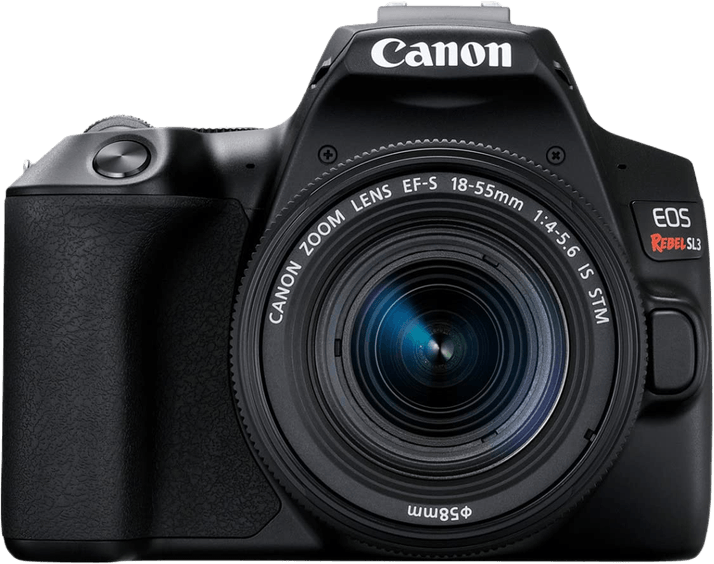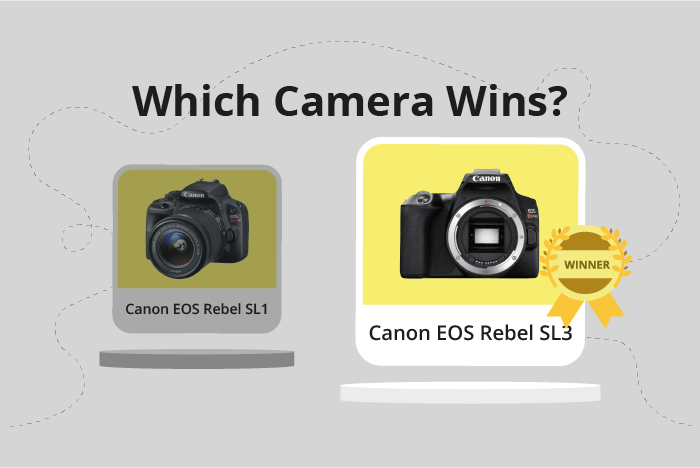Canon EOS Rebel SL1 / 100D vs Rebel EOS SL3 / 250D Comparison
Canon EOS Rebel SL1 / 100D

Canon EOS Rebel SL3 / 250D

The Canon Rebel EOS SL3 / 250D emerges as the winner with a score of 63/100, while the Canon EOS Rebel SL1 / 100D scores 43/100. Both cameras are DSLRs and have similar dimensions, with the SL3 being slightly larger and heavier. They also share a common launch price range, with the SL1 at $650 and the SL3 at $599.
The SL3 outperforms the SL1 due to its more recent release in 2019, compared to the SL1’s 2013 release. This advantage reflects in its higher score and improved features. Conversely, the SL1 has a slight edge in terms of size and weight, making it more compact and portable.
Taking these factors into account, the Canon Rebel EOS SL3 / 250D is the superior choice for its updated features and performance. However, the Canon EOS Rebel SL1 / 100D may still appeal to those prioritizing compactness and portability.
Canon EOS Rebel SL1 / 100D vs Rebel EOS SL3 / 250D Overview and Optics
The Canon Rebel EOS SL3 / 250D outperforms the Canon EOS Rebel SL1 / 100D in optics, scoring 61/100 compared to the SL1’s 40/100. Both cameras have a CMOS sensor, an APS-C sensor size, and are compatible with Canon lenses. However, the SL3 has several advantages over the SL1 that contribute to its superior optics score.
The SL3 boasts 24 megapixels, while the SL1 has 18 megapixels. This difference results in higher image resolution and more detailed photos for the SL3. Additionally, the SL3 has a faster shooting speed of 5 frames per second, compared to the SL1’s 4 frames per second. This allows the SL3 to capture action shots more effectively.
The SL3 also has a more advanced processor, the Digic 8, whereas the SL1 comes with the Digic 5 processor. This contributes to better overall image quality and faster processing times in the SL3. Furthermore, the SL3’s sensor has a slightly higher DXOMARK score of 64, compared to the SL1’s score of 63, indicating better sensor performance.
One significant advantage of the SL3 is its image stabilization feature, which is absent in the SL1. This helps to reduce camera shake and produce sharper images, especially in low-light conditions or when using telephoto lenses.
The SL1 does not have any notable advantages in optics over the SL3. The SL3’s superior megapixel count, shooting speed, processor, and sensor performance, along with its image stabilization feature, make it the clear winner in terms of optics. The SL1, with its lower score, falls short in comparison to the capabilities of the SL3.
Canon EOS Rebel SL1 / 100D vs Rebel EOS SL3 / 250D Video Performance
The Canon Rebel EOS SL3 / 250D emerges as the winner in the video capabilities comparison, scoring 83/100, while the Canon EOS Rebel SL1 / 100D scores 40/100. Both cameras share common specifications, such as having Full HD video resolution and 1920 x 1080 video dimensions. However, the SL3 / 250D outperforms the SL1 / 100D in several aspects, making it the superior choice for video recording.
The winning camera, the SL3 / 250D, boasts 4K video resolution and 3840 x 2160 video dimensions, providing higher quality and more detailed footage compared to the SL1 / 100D. Additionally, the SL3 / 250D offers a maximum video frame rate of 60fps, double the SL1 / 100D’s 30fps, resulting in smoother videos with less motion blur. Furthermore, the SL3 / 250D has built-in time-lapse functionality, enabling users to create stunning time-lapse videos without the need for external software or equipment.
On the other hand, the SL1 / 100D does not offer any distinct advantages over the SL3 / 250D in terms of video capabilities. Its lower score reflects its limitations and lack of features compared to the SL3 / 250D.
Taking all these factors into account, it is clear that the Canon Rebel EOS SL3 / 250D is the better choice for videographers due to its 4K video resolution, higher maximum frame rate, and built-in time-lapse functionality. The Canon EOS Rebel SL1 / 100D, while still capable of producing quality Full HD videos, falls short in comparison and may not meet the demands of users seeking advanced video features and capabilities.
Canon EOS Rebel SL1 / 100D vs Rebel EOS SL3 / 250D Features and Benefits
The Canon Rebel EOS SL3 / 250D emerges as the winner in the features comparison, scoring 70 out of 100, while the Canon EOS Rebel SL1 / 100D scores 57 out of 100. Both cameras share some common specifications, such as a 3-inch screen size and a screen resolution of 1,040,000 dots. Additionally, both cameras are equipped with touchscreens and do not have GPS functionality.
The Canon Rebel EOS SL3 / 250D outperforms the Canon EOS Rebel SL1 / 100D in several aspects. The winning camera has a flip screen, which allows for more versatile shooting angles and easier self-portraits. Furthermore, the SL3 / 250D features WiFi and Bluetooth connectivity, enabling users to transfer images and videos to other devices seamlessly and control the camera remotely.
On the other hand, the Canon EOS Rebel SL1 / 100D has limited advantages over the SL3 / 250D. It lacks a flip screen, WiFi, and Bluetooth connectivity. These missing features result in a lower feature score compared to the SL3 / 250D.
Taking these factors into account, the Canon Rebel EOS SL3 / 250D is the superior camera in terms of features. Its flip screen, WiFi, and Bluetooth capabilities provide users with additional functionality and convenience compared to the Canon EOS Rebel SL1 / 100D. While the SL1 / 100D is still a competent camera, the SL3 / 250D offers more value for photographers seeking modern features in their DSLR.
Canon EOS Rebel SL1 / 100D vs Rebel EOS SL3 / 250D Storage and Battery
The Canon Rebel EOS SL3 / 250D outperforms the Canon EOS Rebel SL1 / 100D in storage and battery with a score of 45/100 compared to the SL1’s 21/100. Both cameras share similarities in storage, having one memory card slot each and accepting SD, SDHC, and SDXC cards. However, the SL3 is UHS-I compatible, providing faster data transfer rates.
The SL3’s battery life is significantly better, offering 1070 shots per charge, while the SL1 only provides 380 shots. Both cameras use different battery types, with the SL3 using an LP-E17 and the SL1 using an LP-E12. Neither camera offers USB charging.
Though the SL1 falls behind in storage and battery performance, it may still be suitable for casual photographers who do not require extended battery life or high-speed data transfers. The SL3, with its superior battery life and UHS-I compatibility, is more suited for photographers who need longer shooting sessions and faster data transfer rates.
Canon EOS Rebel SL1 / 100D vs Rebel EOS SL3 / 250D – Our Verdict
Are you still undecided about which camera is right for you? Have a look at these popular comparisons that feature the Canon EOS Rebel SL1 / 100D or the Canon Rebel EOS SL3 / 250D:
- Canon EOS Rebel T8i / 850D vs Rebel EOS SL3 / 250D
- Canon EOS Rebel SL1 / 100D vs EOS Rebel SL2 / 200D
- Canon EOS Rebel T7 / 2000D vs Rebel EOS SL3 / 250D
- Canon EOS Rebel SL2 / 200D vs Rebel EOS SL3 / 250D
- Canon EOS M50 Mark II vs Rebel EOS SL3 / 250D
- Canon EOS Rebel T7i / 800D vs Rebel EOS SL3 / 250D

